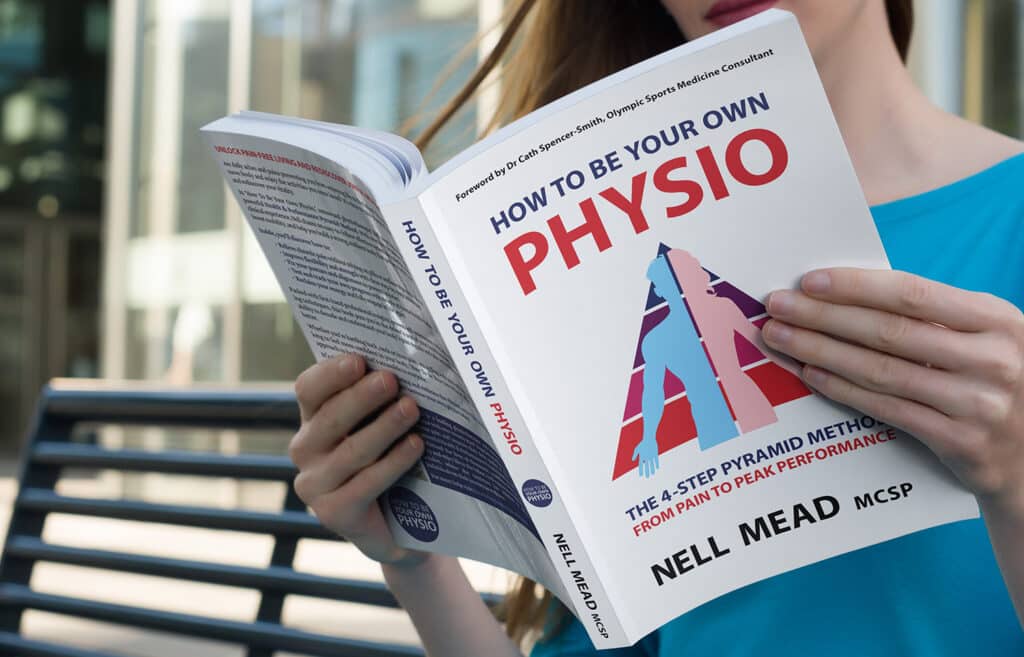Patellofemoral pain syndrome treatment is different for different sufferers. The information below provides information on what it is, and how it can be caused. From the different causes, different treatment plans must be made.
Today I’m looking at one of the commonest places to feel a twinge in your knee — behind or to the side of the kneecap. Pain in this area is called patellofemoral pain because the part being irritated is the joint between the patella (kneecap) and the groove of the femur (thigh bone) in which it sits. But what causes this joint to become irritated?
Read any textbook on anatomy and pathology, and it’ll talk about patellofemoral pain as being one of the commonest issues, for runners, jumpers, cyclists and couch potatoes alike. This is because the mechanism around this joint is relatively delicate and easy to upset — and while it’s rarely the knee itself that’s causing the problem, the knee area is effectively a hinge between two long levers (femur and tibia) so makes a great “victim”.
The patella sits in a groove called the trochlea at the bottom of the femur, or thigh bone. The back of the patella, where it meets the femur, is a V-shape, designed to sit in the centre of the groove and slide up and down as you bend and straighten your knee. The trochlea in turn is also relatively V-shaped, designed to hold the patella in place. The sliding surfaces of both bones are covered in slick, smooth cartilage, and there is space between them, filled with the synovial fluid that keeps the cartilage surfaces healthy and allows for normal gliding movements. The patella is held in place by the quadriceps tendon above (which attaches the patella to the quadriceps muscles) and the patellar tendon below (which attaches the patella to the tibia or shin bone). Do to all the motion this part of the body endures, from above and below, a patellofemoral pain syndrome treatment plan must be based on where the problem originates.
So far, so good. But what happens when this goes wrong?
Well, the ability of the patella to slide smoothly up and down the middle of the groove depends on lots of factors.
Firstly, structure is important, and a big factor in this is the shape of both the patella and the trochlea. The optimal shape is a V-shape, congruent so that the patella sits neatly in the trochlea and doesn’t either slide out or touch the sides. However, in some people, the patella and trochlea form more of an L-shape, with less bony support on the outer side of the groove. This is called patellar dysplasia (the “dysplasia” refers to joints with shallow grooves or sockets), and people with dysplasia are more prone to dislocations which irritate the joint. Another big structural factor is the position of the attachment of the patellar tendon at the tibia — this should be directly below the trochlea, but very occasionally, it can be slightly too far to the inner or outer side, which places awkward forces through the patella and irritates the joint.
If your structure is suboptimal, then you are always going to be at greater risk of pain and dysfunction than someone with perfect alignment; but even people who are structurally perfect can get problems…
If your structure is perfect, but your mechanics (the way you move your structure) are not, then you are at risk. One of the most common things the create a need for patellofemoral pain syndrome treatment I see is from people who have managed to get their femurs or tibias into habitually twisted positions. This in turn causes twisting at the knee joint, and alters the relationship between the trochlea and the patella. For example, if you have a tight hip or pelvis, then your femur could be twisted; or similarly, if you’ve twisted your ankle and are favouring it as you walk, then you may be walking with your tibia twisted. As the muscles that affect the orientation of the patella are attached to the pelvis, femur and tibia, then anything that affects the orientation of these bones may have a knock-on effect on your patella.
Muscle tone is also important. When you walk, you need to be able to contract and extend your hamstring and quadriceps muscles harmoniously in order to allow your patella to slide up and down the groove properly. If, for example, your hamstring (back of thigh) muscles are tight, they may not be as willing to pay out as you stretch your foot forwards towards the ground. You are then more likely to land on your foot while your knee is still slightly bent — this makes your quadriceps work harder (pulling the patella deeper into the groove, and thus risking overloading the cartilage) and also causes you to weight bear at a slightly suboptimal angle, so that you load the wrong part of the joint cartilage.
Good training technique is essential for sporty people who load their knees repetitively. One study found that 90% of cyclists who presented with patellofemoral pain, habitually cycled with their knees pointing slightly out rather than straight ahead! Similarly, if you do a sport that requires a lot of squats or lunges (which, let’s face it, is most sports!) then you need to make sure your knees are well-aligned. A good rule of thumb is to keep the middle of your patella in line with your second toe. To do this efficiently, your glutes will need to be firing well!
Finally, weight management is important. Keeping your weight within the healthy range reduces the amount of load you put through your joints. The more active you are, especially if you do any sort of impact sport such as running or aerobics, the more important this is — one study found that when you jump and land, you load your patellofemoral joint with 2.4–4.6 times your body weight. So it makes sense to keep your bodyweight lower!
So… how can you avoid patellofemoral pain syndrome? Assuming you are structurally sound (and the only way to really be sure is through imaging such as X-ray and MRI), you need to make sure you use your joints as optimally as possible. Your muscles should be strong and flexible (especially glutes, quads, hamstrings and calves) and you should train sensibly and keep your weight in the healthy range. However, given that problems at the patellofemoral joint can arise silently from issues above the knee (causing abnormal movement of the femur) or below the knee (causing abnormal movement of the tibia), if you have any concerns it make sense to see a good physiotherapist for a thorough assessment, and a patellofemoral pain treatment plan – so why not call us on 0207 175 0150 and see how we can help.







